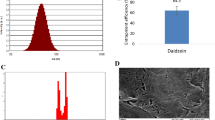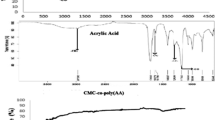Abstract
Colorectal cancer (CRC) is the third most common cancer globally and the second most common cause of cancer-related deaths. Site-specific delivery of drugs leads to an increase in the availability of drugs at the targeted region. The objective of the present investigation was to develop a dually functional microparticulate colon-targeted drug delivery system of meloxicam for potential application in the prophylaxis of colorectal cancer. Chitosan microspheres were prepared by using emulsification–chemical cross-linking technique. Formulation parameters studied include chitosan concentration, drug to polymer ratio, agitation speed, emulsifier concentration, quantity of cross-linking agent and time for cross-linking. In vitro evaluation of microspheres revealed premature release of drug in the upper part of gastrointestinal tract. Since coating of microspheres is difficult to accomplish (with reproducible results), they were compacted to tablets. Enteric coating of tableted microspheres was achieved using Eudragit® S100. In vitro evaluation and SEM studies depict that the microspheres remain intact during compression process. The developed system was further evaluated for in vivo pharmacokinetic and roentgenography studies. In vivo pharmacokinetic evaluation in rabbits reveal that the onset of drug absorption from the coated tableted microspheres (T lag time = 4.67 ± 0.58 h) was significantly delayed compared to uncoated tableted microspheres. In vivo roentgenographic study revealed that the system remained intact, until it reaches to the colonic region (5 h). Thus, from the results of the study, it can be revealed that the developed system could serve as a potential tool for efficient delivery of drug to the colonic region.





Similar content being viewed by others
References
Patel MM. Drug delivery: oral colon-specific. In: Swarbrick J, editor. Encyclopedia of pharmaceutical science and technology. UK: Taylor & Francis Group; 2013. p. 1091–121.
Ashford M, Fell JT, Attwood D, Sharma H, Woodhead PJ. An in vivo investigation into the suitability of pH-dependent polymers for colonic targeting. Int J Pharm. 1993;95:193–9.
Ashford M, Fell JT, Attwood D, Woodhead PJ. An in-vitro investigation into the suitability of pH dependent polymers for colonic targeting. Int J Pharm. 1993;91:241–5.
McConnell EL, Short MD, Basit AW. An in vivo comparison of intestinal pH and bacteria as physiological trigger mechanisms for colonic targeting in man. J Control Release. 2008;130:154–60.
Davis SS, Hardy JG, Fara JW. Transit of pharmaceutical dosage forms through the small intestine. Gut. 1986;27:886–92.
Lee WW, Wilson CG, Mukherji G. Time-dependent systems for colonic delivery. In: Rathbone MJ, Hadgraft J, Roberts MS, editors. Modified-release drug delivery technology. New York: Marcel Dekker; 2003. p. 243–8.
Matsuda KI, Takaya T, Shimoji F, Muraoka M, Yoshikawa M, Takada K. Effect of food intake on the delivery of fluorescein as a model drug in colon delivery capsule after oral to beagle dogs. J Drug Target. 1996;4:59–67.
Ji C, Xu H, Wu W. In vitro evaluation and pharmacokinetics in dogs of guar gum and Eudragit® FS30D-coated colon-targeted pellets of indomethacin. J Drug Target. 2007;15:123–31.
Krishnaiah YS, Veer Raju P, Dinesh Kumar B, Bhaskar P, Satyanarayana V. Development of colon targeted drug delivery systems for mebendazole. J Control Release. 2001;77:87–95.
Tuğcu-Demiröz F, Acartürk F, Takka S, Konuş-Boyunağa O. In-vitro and in-vivo evaluation of mesalazine–guar gum matrix tablets for colonic drug delivery. J Drug Target. 2004;12:105–12.
Krishnaiah YS, Satyanarayana V, Dinesh Kumar B, Karthikeyan RS. In vitro drug release studies on guar gum-based colon targeted oral drug delivery systems of indomethacin. Eur J Pharm Sci. 2002;16:185–92.
Krishnaiah YSR, Styanarayana S, Rama Prasad YV. Evaluation of guar gum as a compression coat for drug targeting to colon. Int J Pharm. 1998;171:137–46.
Turkoglu M, Ugurlu T. In vitro evaluation of pectin–HPMC compression coated 5-aminosalicylic acid tablets for colonic delivery. Eur J Pharm Biopharm. 2002;53:65–73.
Ugurlu T, Turkoglu M, Gurer US, Akarsu BG. Colonic delivery of compression coated nisin tablets using pectin/HPMC polymer mixture. Eur J Pharm Biopharm. 2007;67:202–10.
Patel MM, Amin AF. Formulation and development of release modulated colon targeted system of meloxicam for potential application in the prophylaxis of colorectal cancer. Drug Deliv. 2011;18:281–93.
American Cancer Society. Available from: www.cancer.org/cancer/colonandrectumcancer/detailedguide/colorectal-cancer-key-statistics. Accessed on 30 April 2016.
Elyagoby A, Layas N, Wong TW. Colon-specific delivery of 5-fluorouracil from zinc pectinate pellets through in situ intracapsular ethylcellulose-pectin plug formation. J Pharm Sci. 2013;102:604–16.
Arber N, Levin B. Chemoprevention of colorectal cancer: ready for routine use? Recent Results Cancer Res. 2005;166:213–30.
Giovannucci E, Rimm EB, Stampfer MJ, Colditz GA, Ascherio A, Willett WC. Aspirin use and the risk of colorectal cancer and adenoma in male health professionals. Ann Intern Med. 1994;121:241–6.
Giardiello FM, Offerhaus GJ, DuBois RN. The role of nonsteroidal anti-inflammatory drugs in colorectal cancer prevention. Eur J Cancer. 1995;31:1071–6.
DuBois RN, Giardiello FM, Smalley WE. Non steroidal anti-inflammatory drugs, eicosanoids, and colorectal cancer prevention. Gastroenterol Clin N Am. 1996;25:773–91.
Whittle BJR. COX-1 and COX-2 products in the gut: therapeutic impact of COX-2 inhibitors. Gut. 2000;47:320–5.
Harris RE, Beebe-Donk J, Alshafie GA. Cancer chemoprevention by cyclooxygenase 2 (COX-2) blockade. In: Harris RE, editor. Inflammation in the pathogenesis of chronic diseases: the COX-2 controversy. New York: Springer Science; 2007. p. 193–212.
Sano H, Kawahito Y, Wilder RL, Hashiramoto A, Mukai S, Asai K, Kimura S, Kato H, Kondo M, Hla T. Expression of cyclooxygenase-1 and -2 in human colorectal cancer. Cancer Res. 1995;55:3785–9.
Sheng H, Shao J, Kirkland SC, Isakson P, Coffey RJ, Morrow J, Beauchamp RD, DuBois RN. Inhibition of human colon cancer cell growth by selective inhibition of cyclooxygenase-2. J Clin Invest. 1997;99:2254–9.
Ayakawa S, Shibamoto Y, Sugie C, Ito M, Ogino H, Tomita N, Kumagai M, Murakami H, Sawa H. Antitumor effects of a cyclooxygenase-2 inhibitor, meloxicam, alone and in combination with radiation and/or 5-fluorouracil in cultured tumor cells. Mol Med Rep. 2009;2:621–5.
Churchill L, Graham AG, Shih CK, Pauletti D, Farina PR, Grob PM. Selective inhibition of human cyclooxygenase-2 by meloxicam. Inflammopharmacology. 1996;4:125–35.
Tsubouchi Y, Sano H, Yamada R, Hashiramoto A, Kohno M, Kusaka Y, Kondo M. Preferential inhibition of cyclooxygenase-2 by meloxicam in human rheumatoid synoviocytes. Eur J Pharmacol. 2000;395:255–63.
Goldman AP, Williams CS, Sheng H, Lamps LW, Williams VP, Pairet M, Morrow JD, DuBois RN. Meloxicam inhibits the growth of colorectal cancer cells. Carcinogenesis. 1998;19:2195–9.
Naruse T, Nishida Y, Hosono K, Ishiguro N. Meloxicam inhibits osteosarcoma growth, invasiveness and metastasis by COX-2-dependent and independent routes. Carcinogenesis. 2006;27:584–92.
Tsubouchi Y, Mukai S, Kawahito Y, Yamada R, Kohno M, Inoue K, Sano H. Meloxicam inhibits the growth of non-small cell lung cancer. Anticancer Res. 2000;20:2867–72.
Ko SH, Choi GJ, Lee JH, Han YA, Lim SJ, Kim SH. Differential effects of selective cyclooxygenase-2 inhibitors in inhibiting proliferation and induction of apoptosis in oral squamous cell carcinoma. Oncol Rep. 2008;19:425–33.
Zhang N, Tao K, Huang T. Effects of meloxicam on vascular endothelial growth factor and angiopoietin-2 expression in colon carcinoma cell line HT-29. J Huazhong Univ Sci Technolog Med Sci. 2007;27:399–402.
Patel M, Amin A. Recent trends in microbially and/or enzymatically driven colon-specific drug delivery systems. Crit Rev Ther Drug Carrier Syst. 2011;28:489–552.
Chourasia MK, Jain SK. Design and development of multiparticulate system for targeted drug delivery to colon. Drug Deliv. 2004;11:201–7.
Lorenzo-Lamosa ML, Remunan-Lopez C, Vila-Jato JL, Alonso MJ. Design of microencapsulated chitosan microspheres for colonic drug delivery. J Controlled Rel. 1998;52:109–18.
Paharia A, Yadav AK, Rai G, Jain SK, Pancholi SS, Agrawal GP. Eudragit-coated pectin microspheres of 5-fluorouracil for colon targeting. AAPS PharmSciTech. 2007;8:12.
Krishnamachari Y, Madan P, Lin S. Development of pH- and time dependent oral microparticles to optimize budesonide delivery to ileum and colon. Int J Pharm. 2007;338:238–47.
Thakkar H, Sharma RK, Mishra AK, Chuttani K, Murthy RS. Celecoxib incorporated chitosan microspheres: in vitro and in vivo evaluation. J Drug Target. 2004;12:549–57.
Wang YM, Sato H, Adachi I, Horikoshi I. Optimization of the formulation design of chitosan microspheres containing cisplatin. J Pharm Sci. 1996;85:1204–10.
Patel MM, Amin AF. Process, optimization and characterization of mebeverine hydrochloride loaded guar gum microspheres for irritable bowel syndrome. Carbohydr Polym. 2011;86:536–45.
Patel MM, Amin AA. Design and optimization of colon targeted system of theophylline for chronotherapy of nocturnal asthma. J Pharm Sci. 2011;100:1760–72.
Patel MM, Amin AF. Development of a novel tablet-in-capsule formulation of mesalamine for inflammatory bowel disease. Pharm Dev Technol. 2013;18:390–400.
Patel MM, Patel SL, Bhadani MN, Shah TJ, Amin AF. A synchronous colon specific drug delivery system for orally administered mesalamine. Acta Pharm Sci. 2009;51:251–60.
Patel MM, Shah TJ, Amin AF, Shah NN. Design, development and optimization of a novel time and pH-dependent colon targeted drug delivery system. Pharm Dev Technol. 2009;14:62–9.
Steed KP, Hooper G, Monti N, Benedetti MS, Fornasini G, Wilding IR. The use of pharmacoscintigraphy to focus the development strategy for a novel 5-ASA colon targeting system (“TIME CLOCK®” system). J Control Rel. 1997;49:115–22.
Mathews BR. Regulatory aspects of stability testing in Europe. Drug Dev Ind Pharm. 1999;25:831–56.
Krishnaiah YS, Bhaskar Reddy PR, Satyanarayana V, Karthikeyan RS. Studies on the development of oral colon targeted drug delivery systems for metronidazole in the treatment of amoebiasis. Int J Pharm. 2002;236:43–55.
The international conference on harmonisation of technical requirements for registration of pharmaceuticals for human use. Online 2003. Available from URL: http://www.ich.org/products/guidelines/quality/article/quality-guidelines.
Chourasia MK, Jain SK. Potential of guar gum microspheres for target specific drug release to colon. J Drug Target. 2004;12:435–42.
Jose S, Prema MT, Chacko AJ, Thomas AC, Souto EB. Colon specific chitosan microspheres for chronotherapy of chronic stable angina. Colloids Surf B Biointerfaces. 2011;83:277–83.
Castellanos IJ, Carrasquillo KG, López JD, Alvarez M, Griebenow K. Encapsulation of bovine serum albumin in poly(lactide-coglycolide) micropsheres by the solid-in-oil-in-water technique. J Pharm Pharmacol. 2001;53:167–78.
Xu J, Bovet LL, Zhao K. Taste masking microspheres for orally disintegrating tablets. Int J Pharm. 2008;359:63–9.
Lamprecht A, Yamamoto H, Takeuchi H, Kawashima Y. Design of pH sensitive microspheres for the colonic delivery of the immunosuppressive drug tacrolimus. Eur J Pharm Biopharm. 2004;58:37–43.
Ji CM, Xu HN, Wu W. Guar gum as potential film coating material for colon-specific delivery of fluorouracil. J Biomater Appl. 2009;23:311–29.
Hasegawa A, Nakagawa H, Sugimoto I. Damage of the micro-capsule wall during compression. Yakugaku Zasshi. 1984;104:889–95.
Bamba M, Puisieusx F, Marty JP, Carstensen JT. Release mechanisms in gel forming sustained release preparations. Int J Pharm. 1979;2:307–15.
Gidenne T, Lebas F. Feeding behavior in rabbits. In: Bels V, editor. Feeding in domestic vertebrates: from structure to behavior. Oxfordshire: CABI Publishing; 2006. p. 179–94.
Ishikawa T, Koizumi N, Mukai B, Utoguchi N, Fujii M, Matsumoto M, Endo H, Shirotake S, Watanabe Y. Pharmacokinetics of acetaminophen from rapidly disintegrating compressed tablet prepared using microcrystalline cellulose (PH-M-06) and spherical sugar granules. Chem Pharm Bull (Tokyo). 2001;49:230–2.
Ghosh MN. Fundamentals of experimental pharmacology. 4th ed. Kolkata: SK Ghosh and others; 2008.
Vijayalakshmi P, Devi VK, Devi K, Benson MK, Srinagesh S. Formulation development and in vivo characterization of solubility enhanced gliclazide tablets. Curr trends Biotech Pharm. 2008;2:456–61.
Acknowledgments
The author is thankful to Nirma University, Ahmedabad, Gujarat, India, for providing financial assistance in form of minor research project. The author acknowledges Dr. Bhoomika Patel, Assistant Professor, Department of Pharmacology, Institute of Pharmacy, Nirma University for rendering required help for the in vivo evaluation.
Author information
Authors and Affiliations
Corresponding author
Ethics declarations
ᅟ
In vivo pharmacokinetic studies of the developed CoDDS were carried out as per the protocol (IP/PCEU/FAC/14-1/018) approved by the Institutional Animal Ethics Committee, Nirma University, Ahmedabad, India.
Conflict of interest
The authors declare that they have no conflict of interest.
Rights and permissions
About this article
Cite this article
Patel, M.M. Formulation and development of di-dependent microparticulate system for colon-specific drug delivery. Drug Deliv. and Transl. Res. 7, 312–324 (2017). https://doi.org/10.1007/s13346-017-0358-7
Published:
Issue Date:
DOI: https://doi.org/10.1007/s13346-017-0358-7




